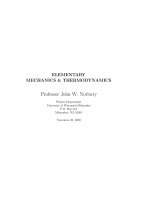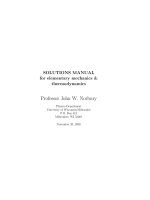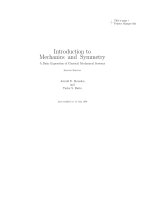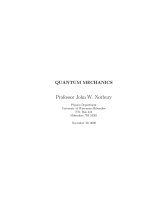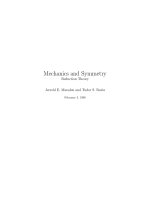- Trang chủ >>
- Khoa Học Tự Nhiên >>
- Vật lý
Elementary mechanics and thermodynamics SOLUTIONS MANUAL j norbury
Bạn đang xem bản rút gọn của tài liệu. Xem và tải ngay bản đầy đủ của tài liệu tại đây (576.73 KB, 112 trang )
SOLUTIONS MANUAL
for elementary mechanics &
thermodynamics
Professor John W. Norbury
Physics Department
University of Wisconsin-Milwaukee
P.O. Box 413
Milwaukee, WI 53201
November 20, 2000
2
Contents
1 MOTION ALONG A STRAIGHT LINE 5
2 VECTORS 15
3 MOTION IN2&3DIMENSIONS 19
4 FORCE & MOTION - I 35
5 FORCE & MOTION - II 37
6 KINETIC ENERGY & WORK 51
7 POTENTIAL ENERGY & CONSERVATION OF ENERGY 53
8 SYSTEMS OF PARTICLES 57
9 COLLISIONS 61
10 ROTATION 65
11 ROLLING, TORQUE & ANGULAR MOMENTUM 75
12 OSCILLATIONS 77
13 WAVES - I 85
14 WAVES - II 87
15 TEMPERATURE, HEAT & 1ST LAW OF THERMODY-
NAMICS 93
16 KINETIC THEORY OF GASES 99
3
4 CONTENTS
17 Review of Calculus 103
Chapter 1
MOTION ALONG A
STRAIGHT LINE
5
6 CHAPTER 1. MOTION ALONG A STRAIGHT LINE
1. The following functions give the position as a function of time:
i) x = A
ii) x = Bt
iii) x = Ct
2
iv) x = D cos ωt
v) x = E sinωt
where A, B, C, D, E, ω are constants.
A) What are the units for A, B, C, D, E, ω?
B) Write down the velocity and acceleration equations as a function of
time. Indicate for what functions the acceleration is constant.
C) Sketch graphs of x, v, a as a function of time.
SOLUTION
A) X is always in m.
Thus we must have A in m; B in m sec
−1
, C in m sec
−2
.
ωt is always an angle, θ is radius and cos θ and sin θ have no units.
Thus ω must be sec
−1
or radians sec
−1
.
D and E must be m.
B) v =
dx
dt
and a =
dv
dt
.Thus
i) v = 0 ii) v = B iii) v = Ct
iv) v = −ωD sin ωt v) v = ωE cos ωt
and notice that the units we worked out in part A) are all consistent
with v having units of m· sec
−1
. Similarly
i) a = 0 ii) a = 0 iii) a = C
iv) a = −ω
2
D cos ωt v) a = −ω
2
E sin ωt
7
i)
ii)
iii)
x
t
v
a
x
x
v
v
a
a
t
t
t
t
t
t
t
t
C)
8 CHAPTER 1. MOTION ALONG A STRAIGHT LINE
iv) v)
0 1 2 3 4 5 6
t
-1
-0.5
0
0.5
1
x
0 1 2 3 4 5 6
t
-1
-0.5
0
0.5
1
x
0 1 2 3 4 5 6
t
-1
-0.5
0
0.5
1
v
0 1 2 3 4 5 6
t
-1
-0.5
0
0.5
1
v
0 1 2 3 4 5 6
t
-1
-0.5
0
0.5
1
a
0 1 2 3 4 5 6
t
-1
-0.5
0
0.5
1
a
9
2. The figures below show position-time graphs. Sketch the correspond-
ing velocity-time and acceleration-time graphs.
t
x
t
x
t
x
SOLUTION
The velocity-time and acceleration-time graphs are:
t
v
t
tt
t
v
t
t
a
t
t
a
t
t
a
t
v
10 CHAPTER 1. MOTION ALONG A STRAIGHT LINE
3. If you drop an object from a height H above the ground, work out a
formula for the speed with which the object hits the ground.
SOLUTION
v
2
= v
2
0
+2a(y − y
0
)
In the vertical direction we have:
v
0
=0, a = −g, y
0
= H, y =0.
Thus
v
2
=0− 2g(0 −H)
=2gH
⇒ v =
2gH
11
4. A car is travelling at constant speed v
1
and passes a second car moving
at speed v
2
. The instant it passes, the driver of the second car decides
to try to catch up to the first car, by stepping on the gas pedal and
moving at acceleration a. Derive a formula for how long it takes to
catch up. (The first car travels at constant speed v
1
and does not
accelerate.)
SOLUTION
Suppose the second car catches up in a time interval t. During that
interval, the first car (which is not accelerating) has travelled a distance
d = v
1
t. The second car also travels this distance d in time t, but the
second car is accelerating at a and so it’s distance is given by
x − x
0
= d = v
0
t +
1
2
at
2
= v
1
t = v
2
t +
1
2
at
2
because v
0
= v
2
v
1
= v
2
+
1
2
at
⇒ t =
2(v
1
− v
2
)
a
12 CHAPTER 1. MOTION ALONG A STRAIGHT LINE
5. If you start your car from rest and accelerate to 30mph in 10 seconds,
what is your acceleration in mph per sec and in miles per hour
2
?
SOLUTION
1hour =60× 60sec
1sec =
1
60 × 60
hour
v = v
0
+ at
a =
v − v
0
t
=
30 mph − 0
10 sec
=3mph per sec
=3mph
1
sec
=3mph
1
(
1
60
×
1
60
hour)
=3× 60 ×60 miles hour
−2
=10, 800 miles per hour
2
13
6. If you throw a ball up vertically at speed V , with what speed does it
return to the ground ? Prove your answer using the constant acceler-
ation equations, and neglect air resistance.
SOLUTION
We would guess that the ball returns to the ground at the same speed
V , and we can actually prove this. The equation of motion is
v
2
= v
2
0
+2a(x − x
0
)
and x
0
=0,x=0,v
0
= V
⇒ v
2
= V
2
or v = V
14 CHAPTER 1. MOTION ALONG A STRAIGHT LINE
Chapter 2
VECTORS
15
16 CHAPTER 2. VECTORS
1. Calculate the angle between the vectors r =
ˆ
i +2
ˆ
j and
t =
ˆ
j −
ˆ
k.
SOLUTION
r.
t ≡|r||
t|cos θ =(
ˆ
i +2
ˆ
j).(
ˆ
j −
ˆ
k)
=
ˆ
i.
ˆ
j +2
ˆ
j.
ˆ
j −
ˆ
i.
ˆ
k − 2
ˆ
j.
ˆ
k
= 0+2−0 −0
=2
|r||
t|cos θ =
1
2
+2
2
1
2
+(−1)
2
cos θ
=
√
5
√
2 cos θ
=
√
10 cos θ
⇒ cos θ =
2
√
10
=0.632
⇒ θ =50.8
0
17
2. Evaluate (r +2
t ).
f where r =
ˆ
i +2
ˆ
j and
t =
ˆ
j −
ˆ
k and
f =
ˆ
i −
ˆ
j.
SOLUTION
r +2
t =
ˆ
i +2
ˆ
j +2(
ˆ
j −
ˆ
k)
=
ˆ
i +2
ˆ
j +2
ˆ
j − 2
ˆ
k
=
ˆ
i +4
ˆ
j − 2
ˆ
k
(r +2
t ).
f =(
ˆ
i +4
ˆ
j − 2
ˆ
k).(
ˆ
i −
ˆ
j)
=
ˆ
i.
ˆ
i +4
ˆ
j.
ˆ
i − 2
ˆ
k.
ˆ
i −
ˆ
i.
ˆ
j − 4
ˆ
j.
ˆ
j +2
ˆ
k.
ˆ
j
= 1+0−0 −0 − 4+0
= −3
18 CHAPTER 2. VECTORS
3. Two vectors are defined as u =
ˆ
j +
ˆ
k and v =
ˆ
i +
ˆ
j. Evaluate:
A) u + v
B) u −v
C) u.v
D) u ×v
SOLUTION
A)
u + v =
ˆ
j +
ˆ
k +
ˆ
i +
ˆ
j =
ˆ
i +2
ˆ
j +
ˆ
k
B)
u −v =
ˆ
j +
ˆ
k −
ˆ
i −
ˆ
j = −
ˆ
i +
ˆ
k
C)
u.v =(
ˆ
j +
ˆ
k).(
ˆ
i +
ˆ
j)
=
ˆ
j.
ˆ
i +
ˆ
k.
ˆ
i +
ˆ
j.
ˆ
j +
ˆ
k.
ˆ
j
= 0+0+1+0
=1
D)
u ×v =(
ˆ
j +
ˆ
k) × (
ˆ
i +
ˆ
j)
=
ˆ
j ×
ˆ
i +
ˆ
k ×
ˆ
i +
ˆ
j ×
ˆ
j +
ˆ
k ×
ˆ
j
= −
ˆ
k +
ˆ
j +0−
ˆ
i
= −
ˆ
i +
ˆ
j −
ˆ
k
Chapter 3
MOTION IN2&3
DIMENSIONS
19
20 CHAPTER 3. MOTION IN2&3DIMENSIONS
1. A) A projectile is fired with an initial speed v
o
at an angle θ with
respect to the horizontal. Neglect air resistance and derive a formula
for the horizontal range R, of the projectile. (Your formula should
make no explicit reference to time, t). At what angle is the range a
maximum ?
B) If v
0
=30km/hour and θ =15
o
calculate the numerical value of
R.
SOLUTION
v
0
v
0
x
v
0
y
range, R
θ
v
0y
= v
0
sin θ
v
0x
= v
0
cos θ
In the x direction we have:
a
x
=0
x − x
0
≡ R
v
x
= v
0x
+ a
x
t
⇒ v
x
= v
0x
R = x − x
0
=
v
x
+ v
0x
2
t =
2v
0x
2
t = v
0
cos θt
21
In the y direction we have:
a
y
= −g
y − y
0
=0
0=y − y
0
= v
0y
t +
1
2
a
y
t
2
= v
0
sin θt−
1
2
gt
2
⇒ v
0
sin θ =
1
2
gt
⇒ t =
2v
0
sin θ
g
⇒ R = v
0
cos θ
2v
0
sin θ
g
=
2v
2
0
cos θ sin θ
g
=
v
2
0
sin 2θ
g
i.e.
R =
v
2
0
sin 2θ
g
which is a maximum for θ =45
o
.
B)
R =
(
30×10
3
m
60×60sec
)
2
sin(2 × 15
o
)
9.8m sec
−2
=
69.4 × 0.5
9.8
m
2
sec
2
m sec
−2
=3.5 m
i.e.
R =3.5 m
22 CHAPTER 3. MOTION IN2&3DIMENSIONS
2. A projectile is fired with an initial speed v
o
at an angle θ with respect
to the horizontal. Neglect air resistance and derive a formula for the
maximum height H, that the projectile reaches. (Your formula should
make no explicit reference to time, t).
SOLUTION
v
0
v
0
x
v
0
y
θ
height, H
We wish to find the maximum height H. At that point v
y
= 0. Also
in the y direction we have
a
y
= −g and H ≡ y − y
0
.
The approporiate constant acceleration equation is :
v
2
y
= v
2
0y
+2a
y
(y − y
0
)
0=v
2
0
sin
2
θ − 2gH
⇒ H =
v
2
0
sin
2
θ
2g
which is a maximum for θ =90
o
, as expected.
23
3. A) If a bulls-eye target is at a horizontal distance R away, derive an
expression for the height L, which is the vertical distance above the
bulls-eye that one needs to aim a rifle in order to hit the bulls-eye.
Assume the bullet leaves the rifle with speed v
0
.
B) How much bigger is L compared to the projectile height H ?
Note: In this problem use previous results found for the range R and
height H, namely R =
v
2
0
sin 2θ
g
=
2v
2
0
sin θ cos θ
g
and H =
v
2
0
sin
2
θ
2g
.
SOLUTION
θ
height, H
range, R
L
24 CHAPTER 3. MOTION IN2&3DIMENSIONS
A) From previous work we found the range R =
v
2
0
sin 2θ
g
=
2v
2
0
sin θ cos θ
g
.
From the diagram we have
tan θ =
L
R
⇒ L = R tan θ =
2v
2
0
sin θ cos θ
g
sin θ
cos θ
=
2v
2
0
sin
2
θ
g
B) Comparing to our previous formula for the maximum height
H =
v
2
0
sin
2
θ
2g
we see that L =4H.
25
4. Normally if you wish to hit a bulls-eye some distance away you need to
aim a certain distance above it, in order to account for the downward
motion of the projectile. If a bulls-eye target is at a horizontal distance
D away and if you instead aim an arrow directly at the bulls-eye (i.e.
directly horiziontally), by what (downward) vertical distance would
you miss the bulls-eye ?
SOLUTION
L
D
In the x direction we have: a
x
=0,v
0x
= v
0
,x−x
0
≡ R.
The appropriate constant acceleration equation in the x direction is
x − x
0
= v
0x
+
1
2
a
x
t
2
⇒ D = v
0
t
t =
D
v
0
In the y direction we have: a
y
= −g, v
0y
=0.
The appropriate constant acceleration equation in the y direction is
y − y
0
= v
0y
+
1
2
a
y
t
2
=0−
1
2
gt
2
=0−
1
2
g(
D
v
0
)
2
but y
0
= 0, giving y =−
1
2
g(
D
v
0
)
2
or L =
1
2
g(
D
v
0
)
2
.

